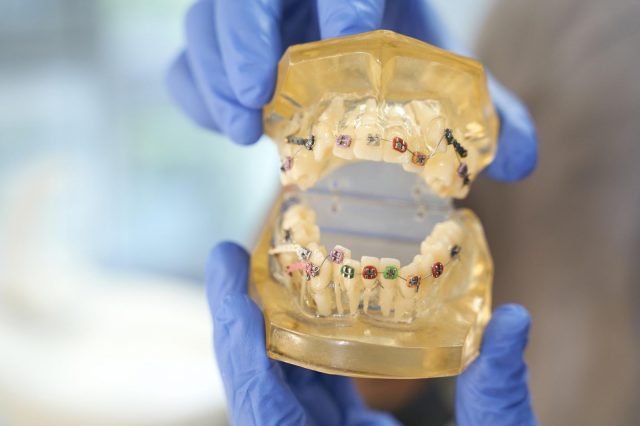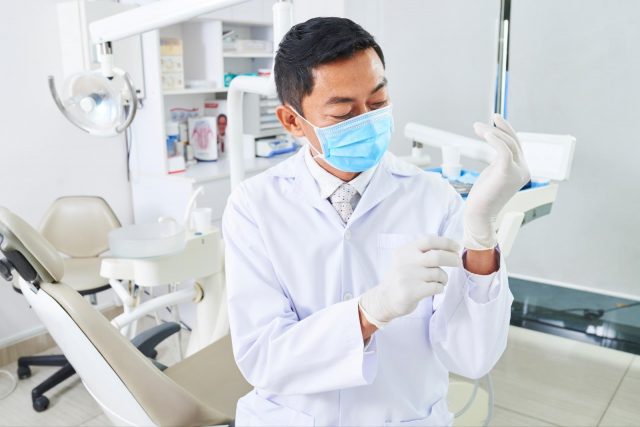Invisalign vs braces; are they not the same thing? How do they work? Which is actually better for you? Invisalign vs braces is a debate that has stood the test of time. These orthodontic appliances are two of the most popular treatments when it comes to teeth straightening.
They both have their pros and cons but which is truly the best? Here is a look at what they are, their pros and cons and how you can choose the right one:
What Is Invisalign?
(Image Source: elements.envato.com)
Invisalign or clear aligners, are invisible braces that gradually straighten teeth. Unlike traditional braces, these braces can be removed, making them more discreet. The process begins with a dentist who is trained in invisalign treatment.
The dentist will usually take digital or physical impressions of your teeth to create a 3D image of your mouth. A customised treatment plan will be mapped out from this image, showing how your teeth will move over time.
Your aligners will be custom made once your treatment plan is finalised. You will have to wear them for around two weeks before changing them out. The treatment typically lasts between 12 to 18 months, removing them only to eat, floss or brush.
What Are Braces?
(Image Source: elements.envato.com)
Braces are a used in traditional orthodontic treatment. These appliances consisting of metal brackets, wires and bands. These components work together to apply controlled pressure, gradually moving the teeth into alignment.
Once a treatment plan is established, brackets will be attached to your teeth using a special adhesive and thread wires. The wires will be periodically adjusted to maintain the desired pressure.
Unlike Invisalign, braces cannot be removed. They also come in various options such as metal, ceramic and self-ligating versions.
Invisalign Advantages
Appearance:
Invisalign aligners are practically transparent braces! They blend seamlessly with your teeth, making them less noticeable. This is particularly appealing to adults and teens concerned about their appearance.
Removable:
Invisalign is removable, allowing for greater flexibility and convenience. You can easily take them out to eat and drink without the dietary restrictions of braces.
This also makes it easier to floss and brush, reducing the risk of tooth decay or gum disease.
Comfort:
Invisalign aligners are made of smooth, comfortable plastic that will not irritate your gums or cheeks. There are no sharp wires or brackets that can poke or scratch inside your mouth.
Fewer Trips to the Dentist:
Traditional braces require frequent check-ups while invisalign aligners do not. This is due to the flexible nature of these aligners where multiple aligners can be issued to you and remote monitoring can be done. The majority of the procedure usually takes place during the 3D printing process.
Invisalign Disadvantages
Compliance:
While the removability of invisalign aligners offers flexibility, it also requires strict compliance. You will have to wear them 20-22 hours per day and failure to do so can compromise results.
Some may find this challenging especially when they forget to wear or remove them.
Limited Effectiveness:
Invisalign may not be suitable for severe orthodontic issues. While the technology has advanced significantly, there are certain dental conditions that are better treated with traditional braces.
Cost:
Invisalign treatment can be more expensive than traditional braces. This depends on factors such as the complexity of the case and the duration of treatment. It is essential to consider your budget and insurance coverage when making a decision.
Braces Advantages
Effectiveness:
Traditional braces are highly effective for correcting a wide range of orthodontic issues. This includes severe crowding, bite misalignment and complex tooth movements.
The combination of brackets, wires, and bands allows for precise control, making braces suitable for even the most challenging cases.
Cost-Effectiveness:
Traditional metal braces tend to be more cost-effective compared to invisalign treatment. This makes them a budget-friendly option for many patients.
While ceramic braces may incur higher costs due to their aesthetics, they are still more cost-effective than Invisalign aligners.
Predictable Results:
Traditional braces have a long track record of success so there is a high chance yours will be a success too! With regular adjustments and proper care, braces can effectively address even the most complex orthodontic issues.
<h3style=”font-family: Arial, Helvetica, sans-serif;”>Non-Removability:
Braces are fixed onto the teeth which means there is no risk of forgetting to wear them or accidentally misplacing them. This continuous application of pressure ensures consistent treatment progress, leading to faster results.
Braces Disadvantages
Aesthetic Concerns:
Traditional braces are more noticeable due to their metal brackets and wires. Some patients may feel self-conscious about the appearance of braces, especially in social or professional settings.
Oral Hygiene Challenges:
The presence of brackets and wires can make it more challenging to maintain good oral hygiene. Food particles and plaque may accumulate around the braces, increasing the risk of tooth decay and gum disease.
Specialised tools, such as interdental brushes and floss threaders, may be required for thorough cleaning.
Discomfort:
Initially, braces may cause discomfort or soreness as the mouth adjusts to the pressure exerted by the brackets and wires. This discomfort may persist after each adjustment appointment as the wires are tightened to maintain tooth movement.
How to Make the Right Decision
(Image Source: elements.envato.com)
Before deciding between Invisalign vs braces, it is essential to get yourself evaluated by a professional. A consultation will give you an idea of how severe your dental correction needs to be.
Some may have straightforward cases that are suited for aligner therapy while others require the precision of traditional braces. If your dentist gives you the option to choose, remember to consider the following factors:
Lifestyle and Preferences:
If you value the ability to remove your orthodontic appliances, Invisalign may be the preferred option. On the other hand, if you prioritise effectiveness, braces may be the better choice.
Cost:
Evaluate the cost of both treatment options, including any potential insurance coverage or financing plans available. While Invisalign may be more expensive, braces require frequent maintenance appointments.
This also includes additional oral hygiene products, affecting the overall cost.
Comfort and Maintenance:
Consider factors like comfort and maintenance for each treatment option. Invisalign aligners are made of smooth plastic and typically cause less discomfort than braces.
Additionally, they offer easier maintenance and fewer dietary restrictions. However, braces may require more diligent oral hygiene practices and specialised cleaning tools to prevent plaque buildup.
Conclusion
Choosing between Invisalign vs braces comes down to several factors. Both have their advantages and disadvantages so it is important to weigh them in before deciding. Ultimately, you must get yourself checked to know what you are dealing with.
So Get in touch and schedule an appointment because dental perfection is just a call away!









